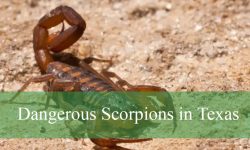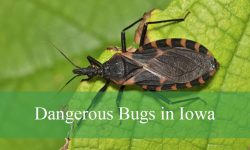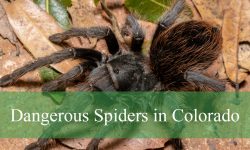California’s warm climate and diverse vegetation make it a haven for many fascinating caterpillar species. While most are harmless and eventually turn into beautiful moths or butterflies, a few can deliver painful stings that cause rashes, swelling, or even severe allergic reactions. These stinging caterpillars use venomous spines or irritating hairs as a defense mechanism against predators.
From the fuzzy Puss Caterpillar to the brightly colored Saddleback Caterpillar, some of these larvae may look soft and harmless but can leave you with an unpleasant surprise. They are often found in gardens, parks, and wooded areas across the state—especially where oak, citrus, or ornamental trees grow.
This guide will help you identify 13 dangerous caterpillars in California, complete with pictures, identification tips, and safety advice. Knowing how to spot and avoid these species will help you enjoy the outdoors safely while appreciating the remarkable diversity of California’s insect life.
Types of Dangerous Caterpillars Found in California
Puss Caterpillar (Megalopyge opercularis)
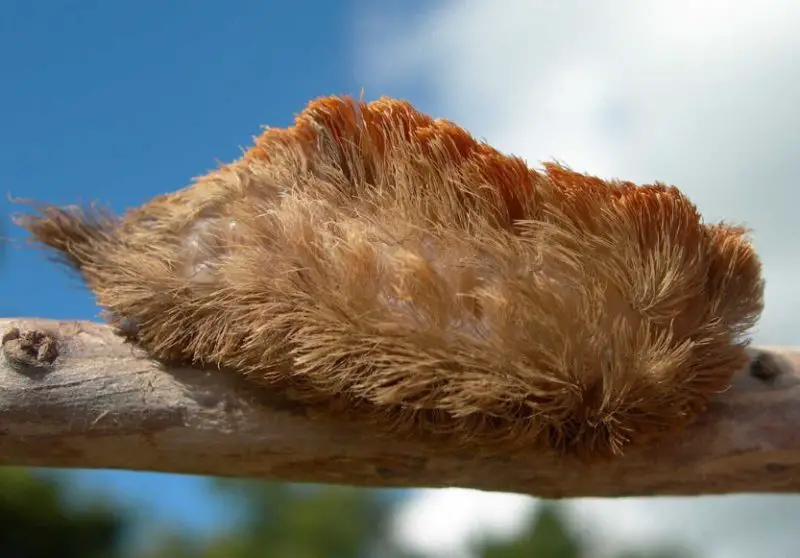
The puss caterpillar, also known as the asp caterpillar, is among the most venomous caterpillars in North America. Despite its soft and inviting appearance, this insect is anything but harmless. Its dense coat of long, silky hairs hides rows of sharp venomous spines capable of delivering a painful sting that can rival that of a bee or even a wasp. Because of its deceptively cute look, people—especially children—are often tempted to touch it, which leads to painful encounters.
This caterpillar is typically about 1 inch long, with its coloration ranging from gray to golden brown or even yellowish-orange depending on its stage of development. The body shape resembles a small tuft of fur or a miniature Persian cat, giving rise to its name “puss caterpillar.” Its velvety texture and rounded shape make it look harmless, but under those fine hairs are hollow spines filled with venom. When pressure is applied, these spines pierce the skin and release toxins.
In California, puss caterpillars are occasionally found in southern and coastal regions where warm and humid conditions favor their development. They tend to live in residential gardens, parks, and wooded areas where oak, elm, or citrus trees grow—their preferred host plants. Adult moths, known as southern flannel moths, emerge later in the year and are often attracted to lights at night, signaling the presence of these dangerous larvae nearby.
A sting from a puss caterpillar can cause immediate and intense pain, described by victims as burning or radiating like an electric shock. The affected area may swell, redden, and develop a rash or small welts. In severe cases, individuals may experience nausea, headache, abdominal pain, or even chest discomfort. The pain typically lasts several hours but may linger for days depending on sensitivity and venom exposure.
If stung, it’s important to avoid rubbing the area, as this can push spines deeper into the skin. Instead, remove any visible hairs or spines using adhesive tape, wash the site with soap and water, and apply a cold compress to reduce pain and swelling. Over-the-counter antihistamines or pain relievers can help manage symptoms. However, if reactions worsen or signs of systemic distress appear, seeking medical attention immediately is highly advised.
Saddleback Caterpillar (Acharia stimulea)
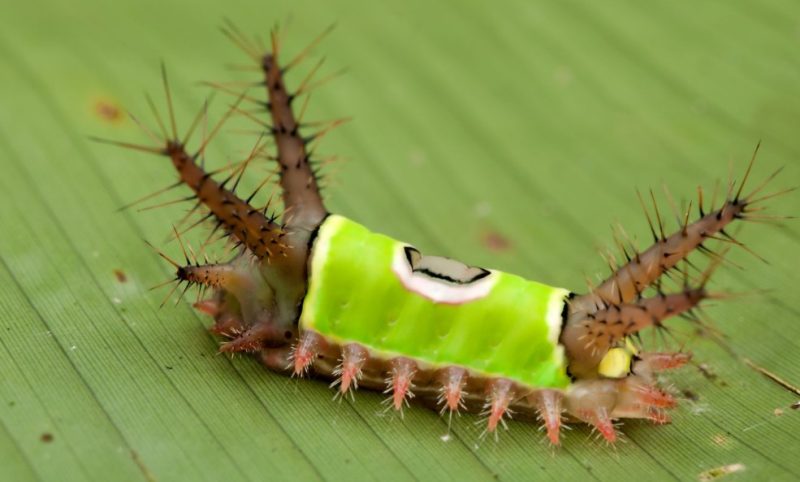
The saddleback caterpillar is one of the most distinctive and deceptively dangerous caterpillars found in the United States. Its bright green body features a bold, dark brown patch in the center that resembles a saddle—hence its name. Along the edges of its body are clusters of venomous spines tipped with sharp bristles. Despite its small size, usually no more than 1 inch long, this caterpillar’s sting can cause severe pain comparable to that of a wasp or hornet.
The body of the saddleback caterpillar is thick and flattened, with small tufts of spines at both ends. The green coloration serves as camouflage, allowing it to blend into leaves, while the saddle-like pattern warns predators of its venomous nature. When disturbed, it arches its body defensively, exposing the sharp spines that inject venom upon contact. These spines are actually hollow hairs connected to small poison glands beneath the skin.
Although it is native to the southeastern and mid-Atlantic regions of the United States, occasional sightings have been reported in southern California, particularly in ornamental gardens and subtropical landscapes. It prefers warm, humid environments and feeds on a wide variety of plants including oak, elm, rose, citrus, and corn. The caterpillar tends to stay on the undersides of leaves, making accidental contact likely for gardeners and outdoor workers.
Stings from the saddleback caterpillar cause immediate, intense burning pain followed by redness, swelling, and raised welts. In some cases, small blisters or even localized numbness may appear. Sensitive individuals might experience headaches, nausea, or lymph node swelling. The pain can last anywhere from a few hours to a full day depending on the reaction.
If stung, gently remove any spines with adhesive tape and wash the area thoroughly with soap and water. Applying ice packs or a baking soda paste can help relieve pain and inflammation. Over-the-counter antihistamines or hydrocortisone cream may also reduce itching and swelling. Because these caterpillars often rest on garden foliage, it’s wise to wear gloves, long sleeves, and protective eyewear when pruning or working around shrubs where they might be hiding.
Io Moth Caterpillar (Automeris io)
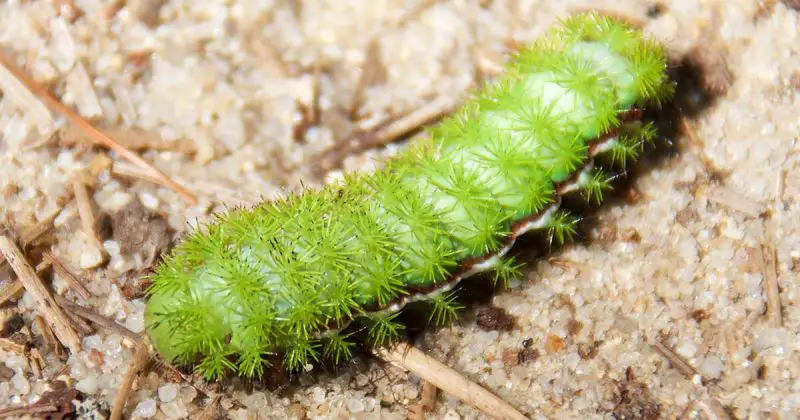
The Io moth caterpillar is one of the most striking yet dangerous caterpillars found in North America. It is easily recognized by its bright green coloration and bold red-and-white stripes running along both sides of its body. Growing up to 2.5 inches in length, this species belongs to the Saturniidae family, known for their large and colorful adult moths. Despite its beautiful appearance, this caterpillar’s venomous spines can cause painful stings that leave lingering irritation.
Each segment of the Io moth caterpillar’s body is lined with clusters of sharp, branching spines that act as a defense mechanism. These spines are connected to venom glands that inject toxins when the skin comes into contact with them. The caterpillar’s vivid coloration serves as a warning to predators—a natural signal of its toxicity. This species undergoes several molts, and its spines become longer and more potent as it matures.
In California, the Io moth caterpillar is not very common but can occasionally be spotted in southern and central regions, especially near farmlands, grasslands, and wooded edges. It feeds on a wide variety of host plants, including willows, maples, clover, corn, and other agricultural crops. Because of this broad diet, it sometimes appears in gardens or along hedgerows, where it can pose a risk to anyone who brushes against it unknowingly.
When touched, the caterpillar’s spines easily penetrate the skin, releasing venom that produces immediate, sharp pain—often compared to a bee sting. The affected area may develop redness, itching, swelling, and raised welts that can last for several hours. In some cases, the pain radiates beyond the contact site, particularly on sensitive skin or in allergic individuals. Though not life-threatening, the sting is highly uncomfortable and best avoided.
To treat a sting, first remove any remaining spines by gently pressing adhesive tape against the skin and peeling it off. Wash the area thoroughly with soap and water to remove any remaining venom, then apply a cold compress to reduce pain and inflammation. Over-the-counter pain relievers or antihistamines can help ease discomfort. If symptoms persist or an allergic reaction develops, medical attention should be sought promptly.
Buck Moth Caterpillar (Hemileuca maia)
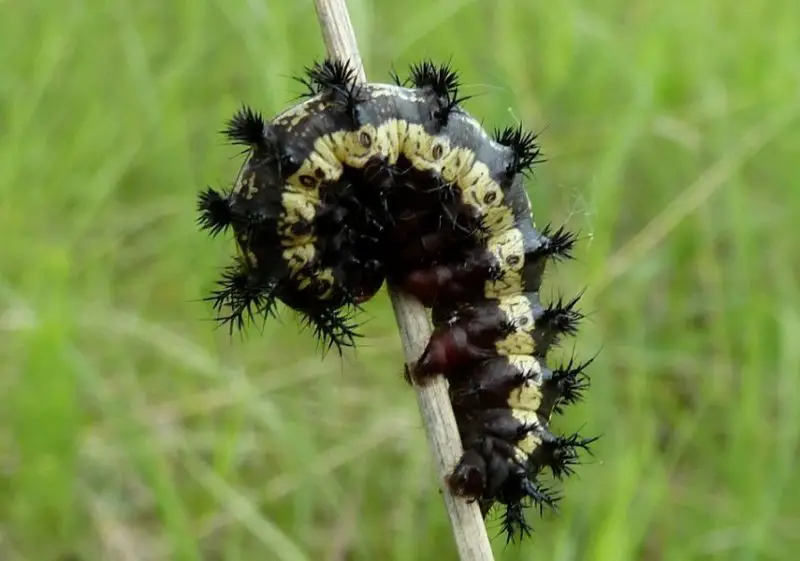
The Buck Moth Caterpillar is a large, dark, and spiny species known for its striking yet menacing appearance. It typically grows up to 2.5 inches long and is covered in clusters of branching, needle-like spines that deliver venom upon contact. Its color ranges from deep brown to nearly black, often highlighted with white or yellowish markings along the sides. Despite its intimidating look, this caterpillar can easily blend in with tree bark or foliage, making accidental encounters more likely during the summer and early fall.
These caterpillars are part of the Hemileuca genus, a group known for their stinging larvae and vividly patterned adult moths. While the Buck Moth (Hemileuca maia) is most common in the eastern United States, several closely related Hemileuca species occur in California, particularly in desert and oak woodland habitats. They prefer feeding on oak and willow trees, where they can gather in large numbers, sometimes defoliating branches when populations are high.
In California, sightings of these spiny caterpillars typically occur during the warmer months when they are actively feeding before pupating. Their habitats often overlap with recreational areas and hiking trails, especially in oak-rich regions, increasing the risk of human contact. Because they blend so well with bark and leaves, people may inadvertently brush against them while collecting firewood or exploring wooded environments.
Contact with the Buck Moth Caterpillar’s spines releases venom that causes immediate burning pain, redness, and swelling. The rash that follows can persist for several hours and may develop small raised bumps or welts. For most individuals, the discomfort is localized, but those with allergies to insect venom may experience stronger reactions, including widespread itching or inflammation.
If stung, carefully remove any visible spines with adhesive tape or tweezers, and wash the affected area with soap and water. Applying a cold compress can reduce swelling and pain. Over-the-counter hydrocortisone cream or oral antihistamines may also help relieve itching and redness. For individuals who experience more severe symptoms, such as dizziness or difficulty breathing, immediate medical care is essential. Avoiding direct contact and wearing long sleeves when near oak trees can help prevent painful encounters with this venomous caterpillar.
Spiny Oak Slug (Euclea delphinii)
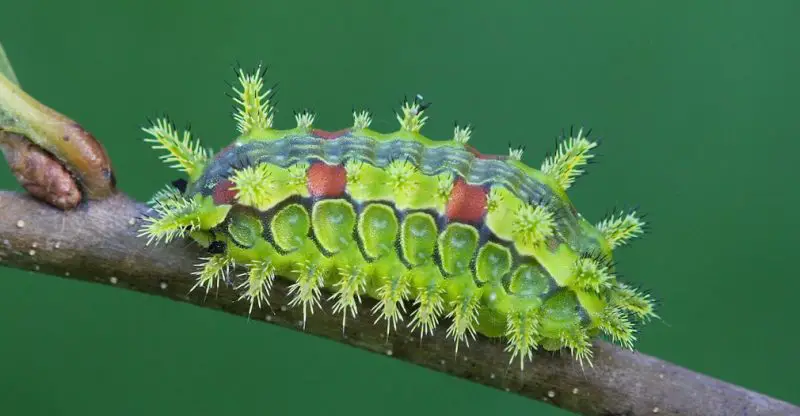
The Spiny Oak Slug is one of the most colorful yet deceptively dangerous caterpillars found in North America. Its small, flattened body—usually less than 1 inch long—is decorated with vivid neon green, orange, and yellow markings, giving it an almost jewel-like appearance. However, beneath this beauty lies a painful defense mechanism: venomous spines that can sting as powerfully as a bee. These spines are arranged in clusters along the back and sides, making any contact with skin extremely unpleasant.
The species is part of the slug moth family (Limacodidae), known for their slug-like movement and bright coloration. The Spiny Oak Slug’s coloration acts as a warning sign to predators, a form of natural aposematism that communicates danger. Each spine contains a tiny venom gland that releases toxins when it penetrates the skin. Even light contact can cause immediate pain, which is often followed by itching or swelling. Despite its small size, this caterpillar’s sting is memorable for anyone who touches it by mistake.
In California, the Spiny Oak Slug appears occasionally in oak forests, wooded parks, and suburban gardens, especially where oak and maple trees are abundant. It feeds primarily on the leaves of oaks, maples, and other hardwood trees. The caterpillars are most active during the late summer and early fall, blending with foliage or resting on the undersides of leaves. While they are not as widespread as in the eastern U.S., sporadic sightings in southern and coastal California have been recorded.
Contact with the Spiny Oak Slug’s venomous spines results in immediate burning or stinging pain, similar to that of a bee or wasp sting. The affected area may turn red, swell, and develop raised welts or small blisters. Most symptoms fade within a few hours, but sensitive individuals might experience itching or irritation lasting longer. In rare cases, multiple stings can lead to more intense localized reactions.
If stung, avoid rubbing the site, as this can embed the spines deeper into the skin. Instead, gently press adhesive tape over the area and peel it off to remove any remaining spines. Wash the skin thoroughly with soap and water to clear away venom residues, then apply a cold compress to reduce pain and inflammation. Over-the-counter pain relievers or antihistamines can ease discomfort. Wearing gloves while gardening and staying alert when handling tree leaves or branches are the best ways to avoid this vividly colored but venomous caterpillar.
Stinging Rose Caterpillar (Parasa indetermina)
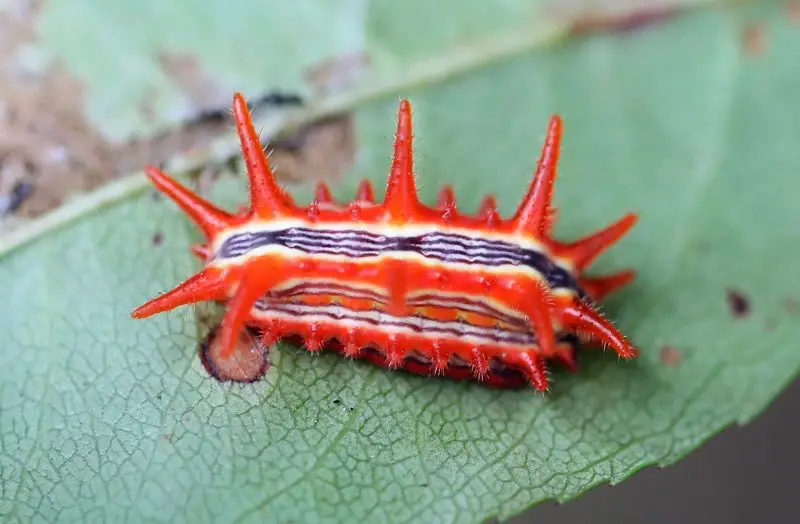
The Stinging Rose Caterpillar is a strikingly beautiful yet highly venomous species known for its dazzling colors and painful sting. Its body ranges from bright yellow to deep red, decorated with vivid blue and orange stripes running along its sides. Along its back and edges are dense clusters of sharp, venomous spines that serve as its main defense. These vibrant hues are not just for show—they act as a clear warning to predators and humans alike to stay away.
This caterpillar belongs to the slug moth family (Limacodidae), a group famous for its colorful but toxic larvae. The Stinging Rose Caterpillar moves with a slow, gliding motion similar to that of a slug, which adds to its unusual appearance. Each of its spines is connected to small venom glands that inject toxins when touched. Even the lightest contact can cause intense burning sensations and long-lasting irritation, making this species one of the more dangerous caterpillars to handle in North America.
Although most common in the eastern and southeastern United States, the Stinging Rose Caterpillar can occasionally appear in California, particularly in ornamental gardens and forested landscapes. It feeds on a variety of host plants, with a strong preference for rose, oak, hickory, and apple trees. Because these plants are often cultivated in residential areas, homeowners or gardeners may accidentally encounter these caterpillars while pruning or tending to shrubs and trees.
The sting from a Stinging Rose Caterpillar is described as immediate and sharp, often accompanied by redness, swelling, and inflammation around the contact site. The affected area may develop welts or blisters that persist for several days. In some cases, the pain can radiate to nearby muscles, and sensitive individuals might experience mild systemic reactions like nausea or headache. Though not typically life-threatening, the discomfort can be intense and long-lasting.
If stung, it’s essential to remove any remaining spines using adhesive tape or tweezers and wash the affected skin thoroughly with soap and water. Applying a cold compress can reduce swelling and numb the pain. Over-the-counter hydrocortisone creams or antihistamines are also effective for easing itching and redness. As a general rule, avoid touching any brightly colored or spiny caterpillars, as their vibrant appearance is nature’s way of signaling that they are armed with venomous defenses.
White-Marked Tussock Moth Caterpillar (Orgyia leucostigma)
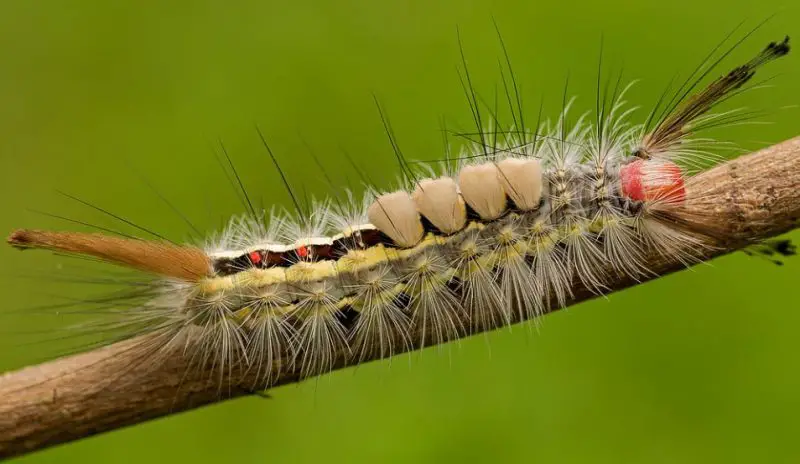
The White-Marked Tussock Moth Caterpillar is one of the most recognizable and widespread species across North America. It is distinguished by its vibrant mix of colors—yellow, white, and black—with distinctive red spots running along its back. Perhaps its most striking feature is the four tufts of white bristles that rise like little toothbrushes from its back, giving it a unique, fuzzy appearance. Despite its soft and ornamental look, this caterpillar can cause skin irritation upon contact, making it one to admire from a distance.
This caterpillar typically grows to about 1.5 inches long and is covered with a variety of hairs—some soft, some barbed—that can easily detach and embed into human skin. Although it’s not venomous like other stinging caterpillars, the barbed hairs can trigger allergic reactions in sensitive individuals. The irritation may appear as redness, itching, or small raised bumps, and in rare cases, airborne hairs can lead to mild respiratory irritation if inhaled.
In California, the White-Marked Tussock Moth Caterpillar is a common sight, especially in oak woodlands, maple groves, and residential areas with fruit trees. They are most active during late spring and early summer, when they feed on a wide variety of host plants including oak, apple, birch, and cherry trees. Their feeding habits can sometimes cause noticeable defoliation, particularly in younger trees or during outbreak years.
While their colorful appearance often draws attention, these caterpillars should never be handled. Brushing against their hairs can cause itching and rashes that last from several hours to a few days. People with sensitive skin may experience more pronounced swelling or irritation. In heavily infested areas, loose hairs may even become airborne, irritating the eyes, nose, or throat. Gardeners, arborists, and outdoor workers are most likely to come into contact with them.
To prevent irritation, wear gloves and long sleeves when working near infested trees or shrubs. If contact occurs, gently wash the affected area with soap and water to remove any hairs and avoid scratching, as this can worsen inflammation. Applying calamine lotion or hydrocortisone cream can soothe itching, while antihistamines help reduce allergic reactions. Though the White-Marked Tussock Moth Caterpillar isn’t venomous, caution is still necessary—its beauty hides tiny barbed hairs that can cause surprisingly uncomfortable skin reactions.
Hag Moth Caterpillar (Phobetron pithecium)
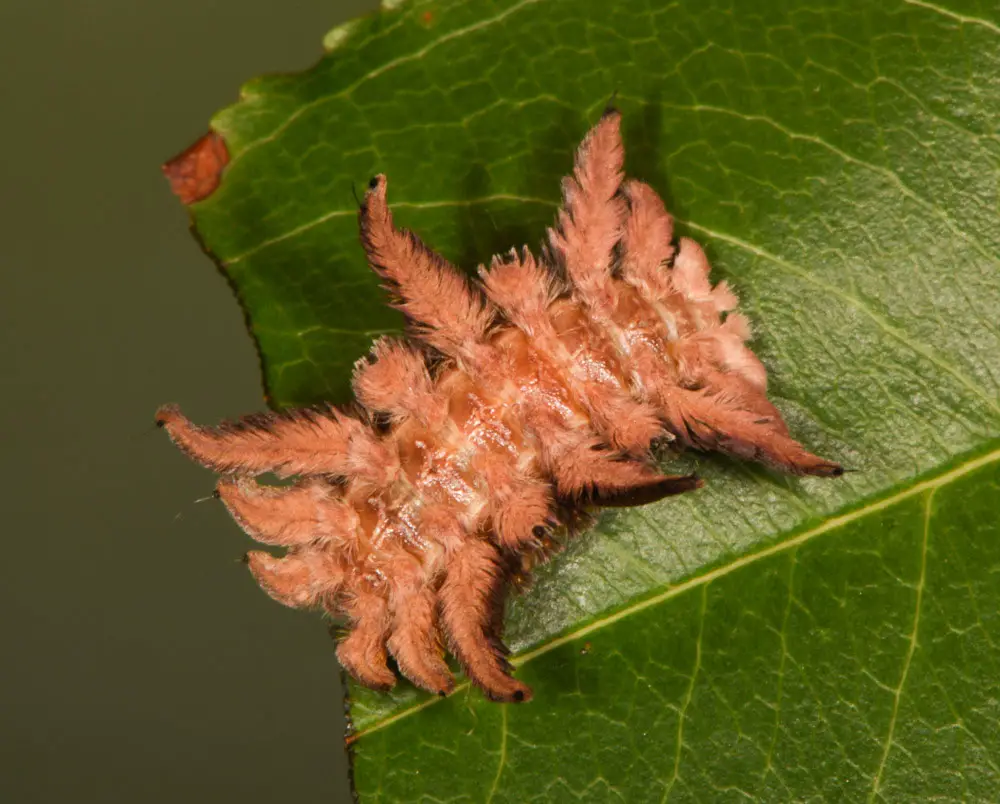
The Hag Moth Caterpillar, often called the Monkey Slug Caterpillar, is one of the strangest and most deceptive insects in North America. With its hairy, star-shaped body and irregular extensions, it looks more like a clump of dead leaves or debris than a living creature. This unusual camouflage helps it avoid predators, but it also makes it easy for people to accidentally brush against it. Beneath its shaggy, brown hairs are venomous spines capable of delivering a painful sting, making this odd-looking caterpillar both fascinating and dangerous.
Measuring about 1 inch long, the Hag Moth Caterpillar has six to eight arm-like projections covered in fine hair. These appendages make it appear almost spider-like or crab-shaped, adding to its bizarre appearance. The dense coat of hair conceals tiny hollow spines that inject venom when they pierce the skin. This defense mechanism protects the caterpillar from birds and other predators, but it can cause an unpleasant surprise for humans who mistake it for a harmless piece of fuzz or leaf litter.
In California, sightings of the Hag Moth Caterpillar are uncommon but possible, particularly in forested or shaded areas with abundant host trees. They are occasionally found in oak woodlands, sycamore groves, and suburban gardens with mature shade trees. The species feeds on a wide range of deciduous plants, including oak, sycamore, apple, and ash. Because they blend in so well with their surroundings, they are often overlooked until an accidental sting occurs.
When touched, the Hag Moth Caterpillar’s venomous spines can cause immediate burning pain, followed by redness and swelling at the site of contact. The discomfort is often compared to that of a wasp sting and may persist for several hours. Some individuals experience itchy welts or mild numbness around the affected area. Though symptoms usually subside on their own, multiple stings or allergic reactions can result in more severe irritation or localized inflammation.
If stung, it’s important not to rub or scratch the area, as this can drive the spines deeper into the skin. Instead, gently apply adhesive tape to the site and peel it off to lift out any embedded spines. Wash the area thoroughly with soap and water, then apply a cold compress to reduce pain and swelling. Over-the-counter antihistamines or hydrocortisone cream can help soothe itching and irritation. Wearing gloves when handling leaves or yard debris is a simple but effective way to avoid painful encounters with this unusual and venomous caterpillar.
Fir Tussock Moth Caterpillar (Orgyia detrita)
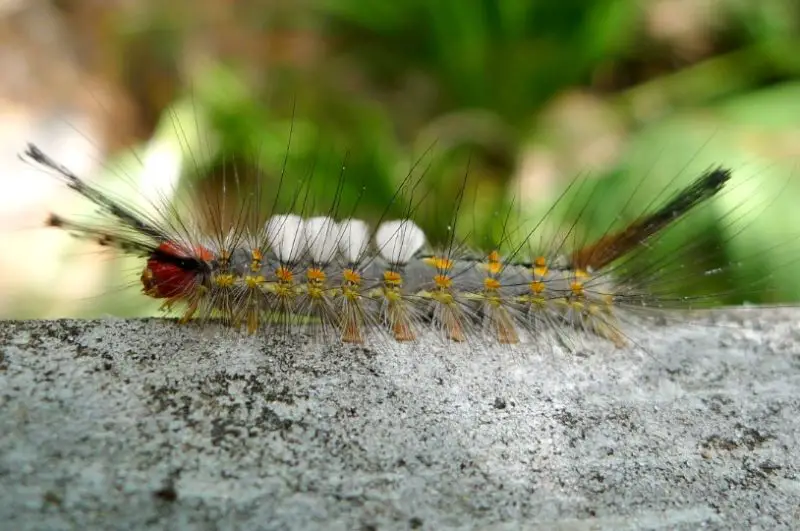
The Fir Tussock Moth Caterpillar is a delicate yet irritating species that stands out for its soft, tufted appearance. Its body is typically white or pale yellow, adorned with small black spots and several long tufts of fine hair rising from its back and sides. These tufts give it a fuzzy, almost feathery look that can make it appear harmless at first glance. However, like other tussock moth caterpillars, its hairs can cause allergic reactions or skin irritation in sensitive individuals, especially upon direct contact.
Although this caterpillar is not venomous in the traditional sense, its barbed hairs can easily break off and embed in the skin, releasing irritating proteins. The result is an itchy rash or mild swelling that may last for several hours. Airborne hairs can also irritate the eyes, nose, or throat, particularly during heavy infestations. For this reason, people working or walking under infested trees may experience discomfort even without touching the caterpillars directly.
In California, the Fir Tussock Moth Caterpillar is most often found in the northern and mountainous regions, where coniferous forests are abundant. It primarily feeds on fir, pine, and spruce trees, but can occasionally appear on ornamental evergreens as well. The caterpillars emerge in late spring and are most active during the summer months, feeding vigorously on needles and sometimes causing significant defoliation when populations are high.
Outbreaks of Fir Tussock Moth Caterpillars can lead to visible damage in forested areas or commercial tree farms. Heavy infestations may weaken trees, leaving them more vulnerable to disease or drought stress. During these times, residents living near infested forests might notice caterpillars descending on silk threads or crawling on outdoor surfaces as they search for new feeding sites or pupation areas.
Contact with these caterpillars may result in itching, redness, or mild swelling at the site of exposure. In most cases, symptoms are temporary and can be relieved by washing the affected area with soap and water, followed by applying a soothing lotion or cold compress. To avoid irritation, it’s best to wear gloves, long sleeves, and protective eyewear when working near infested trees. During peak summer months, avoiding close contact with trees heavily populated by Fir Tussock Moth Caterpillars is the most effective way to prevent allergic reactions and skin discomfort.
Western Tussock Moth Caterpillar (Orgyia vetusta)
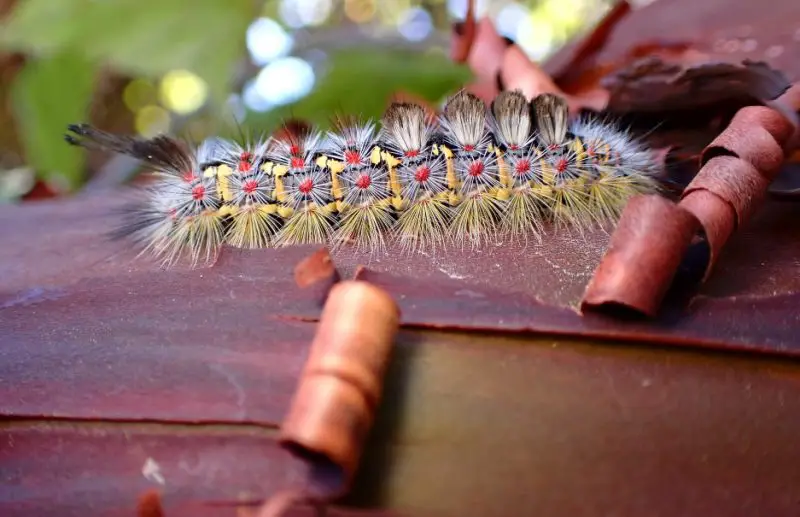
The Western Tussock Moth Caterpillar is one of the most common tussock moth species found across central and southern California, particularly along coastal regions. This eye-catching caterpillar is easily recognized by its distinctive tufts of white hair, a bright red head, and two long black “hair horns” projecting from both its front and rear ends. Its colorful and fuzzy appearance makes it stand out on trees and shrubs, but it should never be touched directly, as its hairs can cause skin irritation.
Despite lacking true venom, the Western Tussock Moth Caterpillar’s fine barbed hairs can detach easily and embed into human skin, triggering itching, redness, or mild rashes—especially for those with sensitive skin. In windy conditions or during heavy infestations, these hairs can become airborne, leading to respiratory or eye irritation. Because the caterpillars often drop from trees on silk threads, it’s easy for people to brush against them without realizing it, particularly when gardening or pruning.
This species thrives in coastal and lowland environments of California, where oak, poplar, and fruit trees provide abundant food sources. It is most active during late spring and summer, feeding on leaves and sometimes causing noticeable defoliation in heavily infested areas. They are also frequently seen around gardens, parks, and orchards, where their feeding habits can impact ornamental and fruit-bearing plants.
The Western Tussock Moth Caterpillar’s population can fluctuate significantly from year to year, and during outbreaks, thousands of individuals may appear on trees or walls. While their presence can be alarming, they pose little long-term danger to trees, as healthy plants typically recover once feeding stops. However, the main concern for humans remains the irritation caused by their loose hairs, which can cling to clothing, furniture, or outdoor surfaces.
To minimize exposure, gardeners and outdoor workers should wear gloves, long sleeves, and masks when handling leaves, sweeping, or pruning in areas with known infestations. If skin irritation occurs after contact, wash the area thoroughly with soap and water and apply a mild antihistamine or hydrocortisone cream to relieve symptoms. Though not venomous, the Western Tussock Moth Caterpillar serves as a good reminder that even harmless-looking insects can cause discomfort if handled carelessly.
California Tortoiseshell Caterpillar (Nymphalis californica)
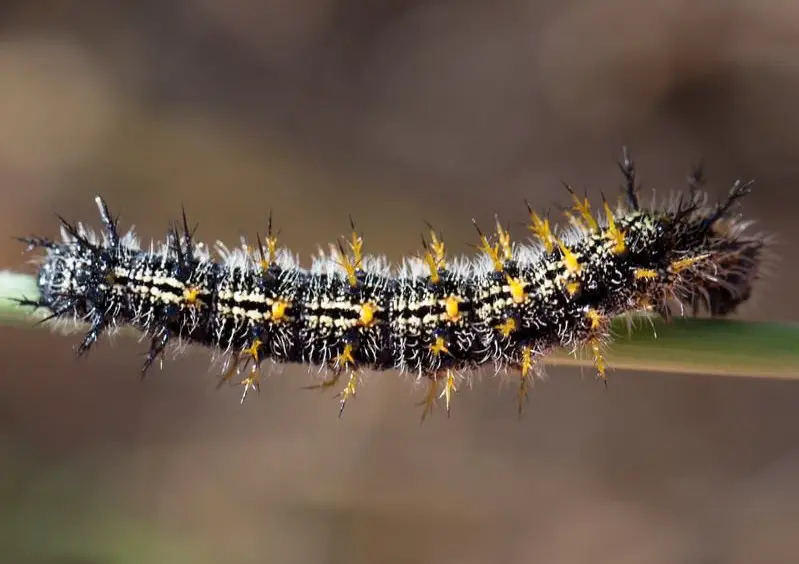
The California Tortoiseshell Caterpillar is a distinctive native species often found in northern California and the Sierra Nevada region. Its body is primarily black, covered with short, sharp spines arranged in neat rows, and accented by bright orange or yellow markings along its sides. Though its appearance might seem intimidating, this caterpillar does not possess true venom. However, its spines can cause mild skin irritation or small scratches if handled directly.
These caterpillars are known for their gregarious behavior, often forming large groups on host plants. They feed primarily on Ceanothus, a native shrub common in California’s foothills and mountain slopes. During late spring and early summer, they can be seen covering branches and stems as they feed and grow, sometimes stripping plants of their leaves when populations are particularly high. This collective feeding behavior is an adaptive strategy for protection against predators and ensures survival through sheer numbers.
The California Tortoiseshell Caterpillar typically measures about 1.5 inches long when fully grown. Its rows of small orange-tipped spines serve as a defense mechanism, deterring birds and small mammals from eating it. When disturbed, the caterpillar may rear up or drop from the plant to escape danger. Despite their slightly prickly appearance, they are harmless when left alone and play an important role in maintaining ecological balance by providing food for native birds and insects.
As they mature, these caterpillars eventually transform into the beautiful California Tortoiseshell Butterfly, recognized by its orange-and-black patterned wings. The adult butterflies are common in summer and early autumn, often gathering in large swarms around mountain regions or near forest clearings. In some years, population booms lead to spectacular butterfly migrations that attract attention from locals and naturalists alike.
If you come into contact with a California Tortoiseshell Caterpillar, you may experience mild itching or redness from its spines. To prevent irritation, avoid handling them with bare hands. If accidental contact occurs, gently wash the affected skin with soap and water to remove any loose spines and apply a soothing lotion or cold compress if needed. Though not dangerous, it’s best to observe these striking caterpillars from a distance and appreciate their role in California’s diverse mountain ecosystems.
Mourning Cloak Caterpillar (Nymphalis antiopa)
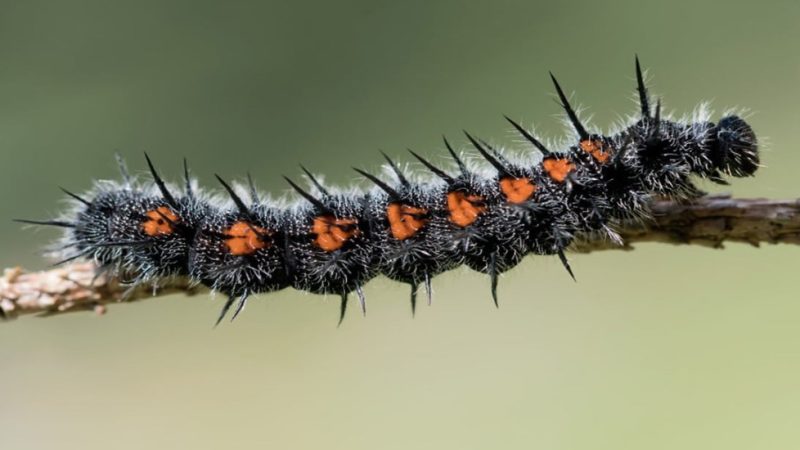
The Mourning Cloak Caterpillar is a dark, spiny species easily recognized by its black body covered with rows of short, stiff spines and bright red or orange spots running along its back. Each spine is surrounded by tiny white dots, giving it a speckled appearance. Although the caterpillar looks intimidating, its spines are not venomous. However, they can still scratch the skin or cause mild irritation if handled, so it’s best admired from a distance.
These caterpillars are the larvae of the Mourning Cloak Butterfly, one of California’s most widespread and resilient butterfly species. They commonly live and feed on willow, poplar, elm, and hackberry trees found throughout the state, from lowland parks to mountain forests. Mourning Cloak Caterpillars often appear in late spring, forming dense clusters on the undersides of leaves or along branches where they feed together before dispersing to pupate.
Their communal behavior offers protection against predators. When disturbed, groups of these caterpillars often thrash their spiny bodies in unison, producing a visual deterrent to birds and insects. The caterpillars grow up to 2 inches long before transforming into chrysalides that later emerge as striking Mourning Cloak Butterflies, identifiable by their deep maroon wings edged in yellow with blue spots near the margins. These butterflies are among the earliest to appear in spring, often emerging from hibernation while snow still lingers.
While the Mourning Cloak Caterpillar is not dangerous, its spines can cause mild irritation, itching, or redness if they come into contact with bare skin. Children and those with sensitive skin are more likely to experience discomfort. The irritation usually fades within a few hours and does not require medical attention unless severe. Because the spines are rigid and slightly hooked, brushing against them can feel like fine splinters.
To avoid irritation, it’s best not to handle these caterpillars directly. If contact occurs, gently wash the area with soap and warm water to remove any loose spines, and apply a cold compress to ease itching or redness. Wearing gloves while gardening or handling leaves from trees known to host Mourning Cloak Caterpillars is a simple precaution. Although not venomous, these caterpillars remind us that even harmless-looking insects can cause minor discomfort if touched carelessly.
Flannel Moth Caterpillar (Megalopyge crispata)
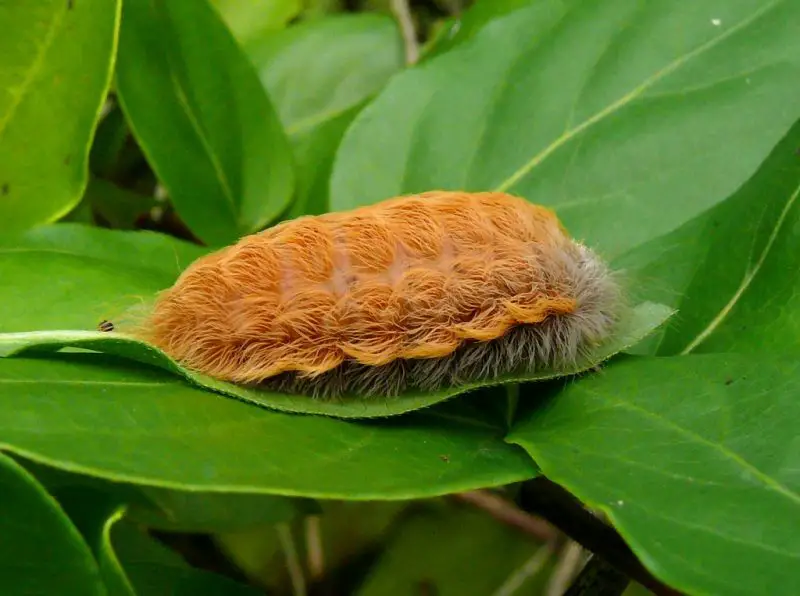
The Flannel Moth Caterpillar, also known as the Southern Flannel Moth Caterpillar, is a fuzzy, soft-bodied larva closely related to the infamous Puss Caterpillar but considerably less venomous. Covered in long, silky hairs that resemble a piece of cotton or a tuft of fur, this caterpillar has a charming, almost harmless look that conceals its mild defensive capability. Beneath its fine coat of “fur,” short spines can cause irritation when touched, producing a mild burning or stinging sensation in some individuals.
In California, this species appears sporadically, mainly in the southern regions with warm climates and abundant deciduous trees. It tends to inhabit gardens, parks, and wooded areas where it can feed on oak, elm, or other broadleaf trees. The Flannel Moth Caterpillar is well-camouflaged, blending easily among leaves or branches, making it difficult to notice until contact occurs.
Though its sting is far less severe than that of its southern cousin, the Puss Caterpillar, it can still cause mild discomfort such as redness, swelling, or a tingling sensation on the skin. These symptoms typically fade within a few hours. To stay safe, avoid touching any caterpillar covered in dense or silky hair. If stung, gently remove any remaining hairs with adhesive tape, wash the affected area with soap and water, and apply a cool compress to relieve irritation. Despite its soft and inviting appearance, the Flannel Moth Caterpillar is best appreciated from a respectful distance.
FAQs About Dangerous Caterpillars in California
What are the most dangerous caterpillars found in California?
Some of the most dangerous caterpillars in California include the Puss Caterpillar (Megalopyge opercularis), Saddleback Caterpillar (Acharia stimulea), Io Moth Caterpillar (Automeris io), Hag Moth Caterpillar (Phobetron pithecium), and Spiny Oak Slug (Euclea delphinii). These species have venomous spines or irritating hairs that can cause painful stings and allergic reactions.
Where are stinging caterpillars usually found in California?
Stinging caterpillars are most often found in southern and coastal California, particularly in areas with oak, citrus, or ornamental trees. They thrive in gardens, wooded parks, and rural landscapes, where host plants are abundant. Many species rest on the undersides of leaves, making them difficult to spot.
When are dangerous caterpillars most active in California?
Most venomous and stinging caterpillars are active from late spring through early fall. This is their feeding and growing season, coinciding with warm temperatures and lush vegetation. During this period, they can be seen on tree trunks, shrubs, and garden plants.
What happens if you touch a stinging caterpillar?
Touching a stinging caterpillar can result in immediate burning pain, followed by redness, swelling, and itching. Some species may cause blistering or rashes that last several hours or even days. Severe reactions, though rare, can include nausea, headaches, or difficulty breathing in allergic individuals.
How should you treat a caterpillar sting?
If stung, do not rub the area, as this may spread the venom. Instead, use adhesive tape to gently remove any remaining spines or hairs. Wash the skin with soap and water, then apply a cold compress or ice pack to reduce pain and swelling. Antihistamines or hydrocortisone cream can help relieve itching. Seek medical attention if the pain is severe or symptoms worsen.
Can caterpillar stings be dangerous to pets?
Yes. Dogs and cats may experience swelling of the mouth, drooling, or paw irritation if they lick or bite a stinging caterpillar. Contact your veterinarian immediately if your pet shows any signs of discomfort or allergic reaction after exposure.
Are all fuzzy or hairy caterpillars poisonous?
Not all hairy caterpillars are venomous, but as a general rule, it’s best to avoid touching any fuzzy or brightly colored caterpillar. Many non-venomous species mimic toxic ones as a defense mechanism, making it hard to distinguish between harmless and dangerous types.
How can I prevent caterpillar stings in my garden?
To stay safe, always wear gloves, long sleeves, and protective clothing while gardening or pruning. Inspect foliage carefully, especially on oak, citrus, and ornamental plants, where stinging caterpillars tend to hide. Teaching children not to touch caterpillars is also essential for safety.
Do dangerous caterpillars become dangerous moths or butterflies?
Most stinging caterpillars transform into harmless adult moths. The venomous spines are only present during the larval stage as a defense mechanism against predators. Once they pupate, they lose their toxic hairs and pose no threat.
Can dangerous caterpillars infest homes or indoor plants?
It’s rare for stinging caterpillars to infest homes, but they can occasionally appear indoors if they wander in on garden plants or firewood. They prefer outdoor environments with natural host plants, so indoor infestations are extremely uncommon.



